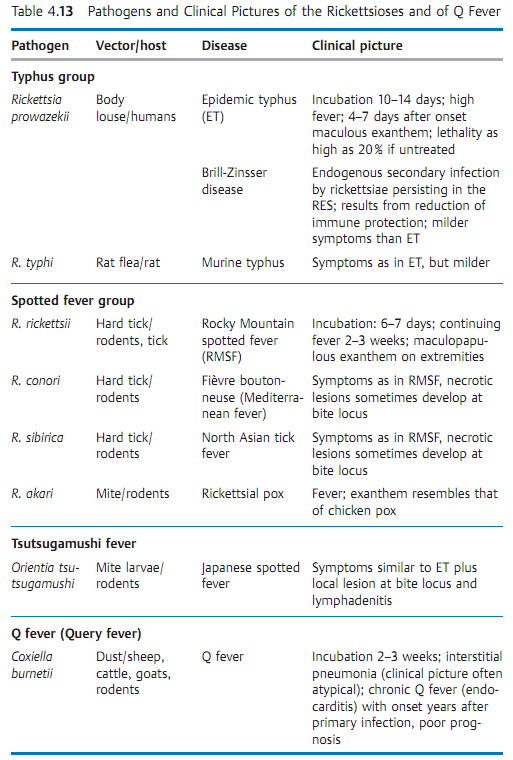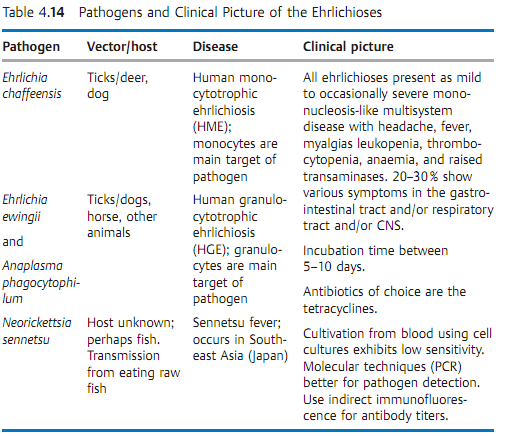


 النبات
النبات
 الحيوان
الحيوان
 الأحياء المجهرية
الأحياء المجهرية
 علم الأمراض
علم الأمراض
 التقانة الإحيائية
التقانة الإحيائية
 التقنية الحيوية المكروبية
التقنية الحيوية المكروبية
 التقنية الحياتية النانوية
التقنية الحياتية النانوية
 علم الأجنة
علم الأجنة
 الأحياء الجزيئي
الأحياء الجزيئي
 علم وظائف الأعضاء
علم وظائف الأعضاء
 الغدد
الغدد
 المضادات الحيوية
المضادات الحيوية|
Read More
Date: 13-3-2016
Date: 13-3-2016
Date: 10-3-2016
|
Rickettsia, Coxiella, Orientia, and Ehrlichia
The genera of the Rickettsiaceae and Coxelliaceae contain short, coccoid, small rods that can only reproduce in host cells. With the exception of Coxiella (aerogenic transmission), they are transmitted to humans via the vectors lice, ticks, fleas, or mites. R. prowazekii and R. typhi cause typhus, a disease characterized by high fever and a spotty exanthem. Several rickettsiae species cause spotted fever, a milder typhus like disease. Orientia tsutsugamushi is transmitted by mite larvae to cause tsutsugamushi fever. This disease occurs only in Asia. Coxiella burnetii is responsible for Q fever, an infection characterized by a pneumonia with an atypical clinical course.
Several species of Ehrlichiaceae cause ehrlichiosis in animals and humans. The method of choice for laboratory diagnosis of the various rickettsioses and ehrlichioses is antibody assay by any of several methods, in most cases indirect immunofluorescence. Tetracyclines represent the antibiotic of choice for all of these infections. Typhus and spotted fever no longer occur in Europe. Q fever infections are reported from all over the world. Sources of infection include diseased sheep, goats, and cattle. The prognosis for the rare chronic form of Q fever (syn. Q fever endocarditis) is poor. Ehrlichiosis infects mainly animals, but in rare cases humans as well.
Classification. The bacteria of this group belong to the families Rickettsiaceae (Rickettsia and Orientia), Coxelliaceae (Coxiella), and Ehrlichiaceae (Ehrlichia, Anaplasma, Neorickettsia). Some of these organisms can cause mild, self- limiting infections in humans, others severe disease. Arthropods are the transmitting vectors in many cases.
Morphology and culture. These obligate cell parasites are coccoid, short rods measuring 0.3-0.5 µm that take gram staining weakly, but Giemsa staining well. They reproduce by intracellular, transverse fission only. They can be cultured in hen embryo yolk sacs, in suitable experimental animals (mouse, rat, guinea pig) or in cell cultures.
Pathogenesis and clinical pictures. With the exception of C. burnetii, the organisms are transmitted by arthropods. In most cases, the arthropods excrete them with their feces and ticks transmit them with their saliva while sucking blood. The organisms invade the host organism through skin injuries. C. burnetii is transmitted exclusively by inhalation of dust containing the pathogens. Once inside the body, rickettsiae reproduce mainly in the vascular endothelial cells. These cells then die, releasing increasing numbers of organisms into the bloodstream. Numerous inflammatory lesions are caused locally around the destroyed endothelia. Ehrlichiae reproduce in the monocytes or granulocytes of membrane-enclosed cytoplasmic vacuoles. The characteristic morulae clusters comprise several such vacuoles stuck together.
Table 4.13 summarizes a number of characteristics of the rickettsioses.
Diagnosis. Direct detection and identification of these organisms in cell cultures, embryonated hen eggs, or experimental animals is unreliable and is also not to be recommended due to the risk of laboratory infections. Special laboratories use the polymerase chain reaction to identify pathogen-specific DNA sequences. However, the method of choice is currently still the antibody assay, whereby the immunofluorescence test is considered the gold standard among the various methods. The Weil-Felix agglutination test is no longer used today due to low sensitivity and specificity.
Therapy. Tetracycline lower the fever within one to two days and are the antibiotics of choice.
Epidemiology and prevention. The epidemic form of typhus, and earlier scourge of eastern Europe and Russia in particular, has now disappeared from Europe and occurs only occasionally in other parts of the world. Murine typhus, on the other hand, is still a widespread disease in the tropics and subtropics. Spotted fevers (e.g., Rocky Mountain spotted fever) occur with increased frequency in certain geographic regions, especially in the spring. Tsutsugamushi fever occurs only in Japan and Southeast Asia. The bloodsucking larvae of various mite species transmit its pathogen. Q fever epidemics are occasionally seen worldwide. The sources of infection are diseased livestock that eliminate the coxiellae in urine, milk, or through the birth canal. Humans and animals are infected by inhaling dust containing the pathogens. Specific preventive measures are difficult to realize effectively since animals showing no symptoms may be excreters.


Active vaccination of persons exposed to these infections in their work provides a certain degree of immunization protection. Until 1987, ehrlichioses were thought to occur only in animals. Tickborne Ehrlichia infections in humans have now been confirmed.



|
|
|
|
للعاملين في الليل.. حيلة صحية تجنبكم خطر هذا النوع من العمل
|
|
|
|
|
|
|
"ناسا" تحتفي برائد الفضاء السوفياتي يوري غاغارين
|
|
|
|
|
|
|
ملاكات العتبة العباسية المقدسة تُنهي أعمال غسل حرم مرقد أبي الفضل العباس (عليه السلام) وفرشه
|
|
|